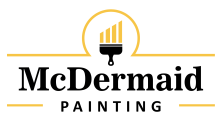How to Choose a Home Exterior Color

A new year signifies a new chapter in our lives. Many of us make New Year’s resolutions focusing on self-improvement, ranging from eating healthier to exercising more and everything in between. However, improvement resolutions aren’t limited to personal habits; they can also be used to enhance the beauty and value of your home.
One way to give your home a fresh, new look for 2020 is to paint its exterior. Before you rush out to select a paint color, keep in mind that painting the outside of your home is much different than painting the inside. While your interior paint colors reflect your personal tastes and preferences, the exterior paint color not only needs to work with your home’s landscaping and hardscaping but also “fit in” with the other homes on your street.
Thus, the process of deciding on an exterior color scheme should take a little more time and research. Here are some tips in choosing a color palette that reflects your style and complements your home’s natural elements:
Consider your home’s surroundings. Chances are you won’t be doing a full renovation when you’re painting the outside of your home. The paint color(s) should complement the roof shingles, stonework, and pathways that are permanent fixtures of your property. For example, if your pathways are a warm tone (i.e. beige, rust) choose a cooler tone (i.e. gray, blue) for the exterior paint color.
Honor the architectural style. Your color palette should enhance the architectural style of your home. If you have a Victorian home, bright orange or green would be out of character for the period. Many paint manufacturers provide historically accurate color palettes in case you need a starting point in choosing appropriate colors. If you still need inspiration, one of our color consultants can help you create a scheme that reflects the style of your home as well as your personal tastes.
Select several shades. A home’s exterior color scheme has three parts: field color, accent color, and trim color. The field color is the main color of the home, the accent color is used on doors or shutters, and the trim color is using for door and window casings as well as other trim. Traditionally there is a strong contrast between the main and trim colors; however, the monochromatic look with one or two colors is also trending. If you choose not to have basic white for your home’s trim, select a color a few shades lighter than the main color for a subtle yet elegant effect.
Test your colors. Swatches are a great starting point, but the chip color may vary significantly from the way it appears on your home’s exterior. To ensure you’ll be happy with the color palette for years to come, buy test sizes of potential paint colors and test them on inconspicuous parts of the exterior, including near the trim and the north and south sides of your home. Visit the test area at various times during the day, as the color can change dramatically.
Invest in a premium paint. Painting your home’s exterior is about durability and protecting your biggest investment. To prevent you or professional from having to climb a ladder to repaint in a few years, choose a paint that has full coverage, is resistant to change, and can stand up to the weather elements.
McDermaid Painting serves Palo Alto and surrounding areas with high-quality painting and restoration workmanship for any size project. If you would like to get started with a free consultation, contact us today at (650) 961-7415. Visit our Facebook page or website to explore what we can do for you.
Sources
https://www.hgtv.com/remodel/outdoors/20-inviting-home-exterior-color-palettes-pictures
https://www.diynetwork.com/how-to/skills-and-know-how/painting/how-to-select-exterior-paint-colors-for-a-home
https://www.thespruce.com/exterior-paint-colors-with-visualizer-4071366
